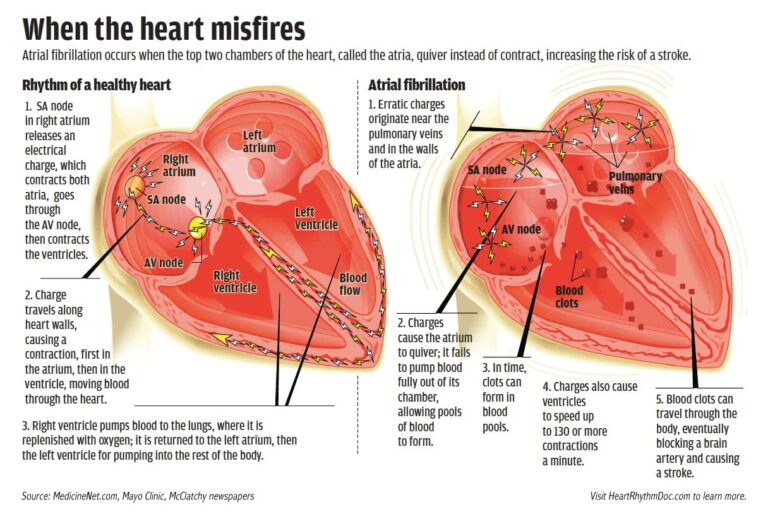The Normal Heart Rhythm
Your heart normally beats about 100,000 times a day, which translates to 60-100 beats per minute. It does this in an orderly fashion, controlled by a steady stream of electrical impulses.
The heart consists of two upper chambers, called the atria, and two lower chambers, called the ventricles. Electrical impulses that coordinate the heart’s contractions originate at the sinoatrial node — also called the sinus node or SA node. The SA node is a bundle of highly specialized cells in the right atrium.
The signal passes through the right and left atria, telling them to contract. When the atria contract, oxygen-rich blood is pushed into the ventricles. Then the atrioventricular node, or AV node, receives the signal and passes it into the ventricles, telling them to contract. When the ventricles contract, blood is pumped out of the heart into the body.

this infographic describes atrial fibrillation, a type of abnormal heart rhythm.
Click the image to open a larger version.
Abnormal Heart Rhythms (Arrhythmias & Tachycardias)
Sometimes, however, the flow of electrical impulses changes. The sinus node may send out signals too quickly, or it may send out extra signals. In other cases, the signals bounce around inside one of the heart’s chambers instead of moving on in a regular pattern. The result is a fast or irregular heartbeat. These abnormal rhythms are called arrhythmias. When the heart beats erratically, it does not pump blood as efficiently as it should, shortchanging the delivery of oxygen throughout the body.
When this abnormal rhythm results in a heart rate that is faster than normal, it is called tachycardia. Tachycardias are given different names depending on where the abnormal signal originated. For example:
- When the SA node in the right atrium misfires, the resulting abnormal rhythms are called atrial arrhythmias or atrial tachycardias.
- Abnormal rhythms that arise from the AV node are called ventricular tachycardias.
- Sometimes the abnormal signals bounce around inside one of the heart’s chambers; this is called a re-entrant tachycardia.
- Arrhythmias that originate at the SA node or in the atria are also sometimes called supraventricular (literally, “above the ventricles”) tachycardias; they may affect both the atria and the ventricles.
We do not yet fully understand what causes the heart’s electrical system to misfire. Tachycardias occur often among people who have had previous heart trouble, particularly those whose heart has been damaged by a heart attack or surgery. They are also more common as a person ages, so people over the age of 65 are at greater risk.
Most arrhythmias are harmless and occur in people with healthy hearts. Some are a natural response, such as the heart beating faster in order to meet your body’s demand for increased oxygen when you exercise. But sometimes they are dangerous — and can even be fatal.
“On January 31, 2012 you performed an ablation on my heart in Tampa. I was referred to you by Dr. Landis.
Gail K.
I am writing once again to say thank you! I truly am so very grateful to you! I feel great and continue to tell people about the quality of your work and your dedication.
May you be blessed with good health, happiness, and continued success.”
Get Help from a Care Coordinator
Abnormal Heart Rhythm Symptoms
Some patients with tachycardias have no symptoms, while others are severely impaired. Symptoms cover a wide range, from feeling lightheaded to sudden cardiac death. Symptoms are caused by the lack of steady blood flow to the body and can include:
- Palpitations
- Rapid heart rate
- Shortness of breath
- Chest pain
- Dizziness
- Lightheadedness
- Fainting
Diagnosing Fast Heartbeats
- Echocardiogram
- 24-hour electrocardiogram, or ECG (in which you wear a vest-like device called a “Holter monitor” during normal activity for 24 hours)
- Electrophysiology study (used by the EP Doctor to locate the origin of the rhythm disorder and determine the best treatment)

